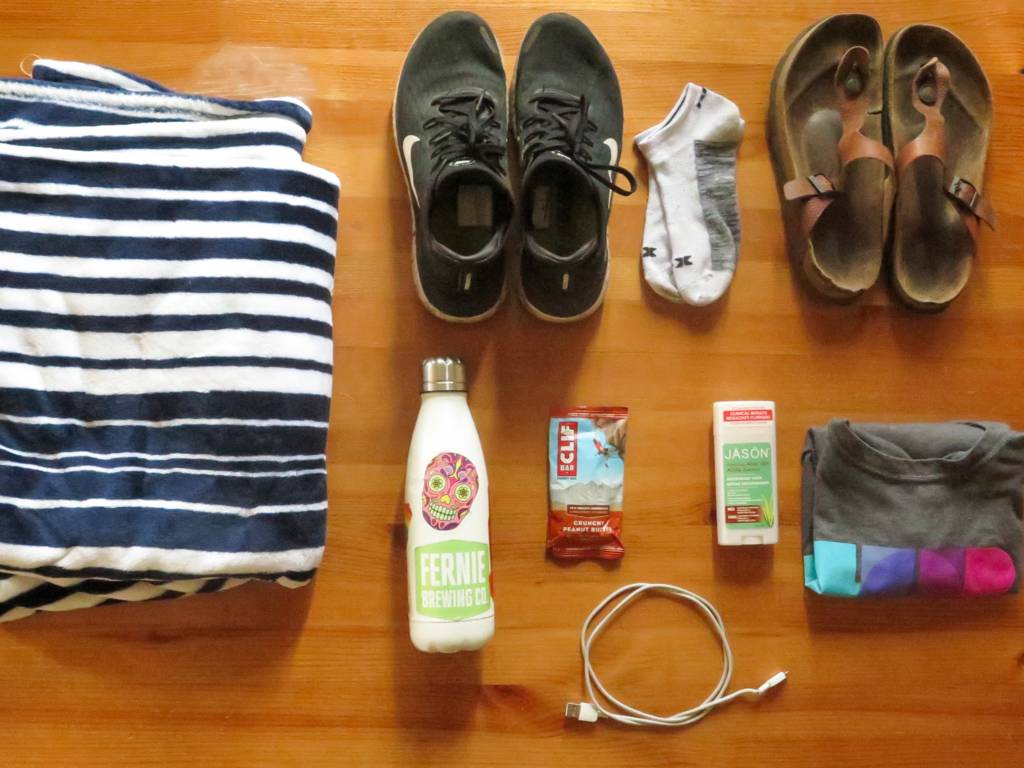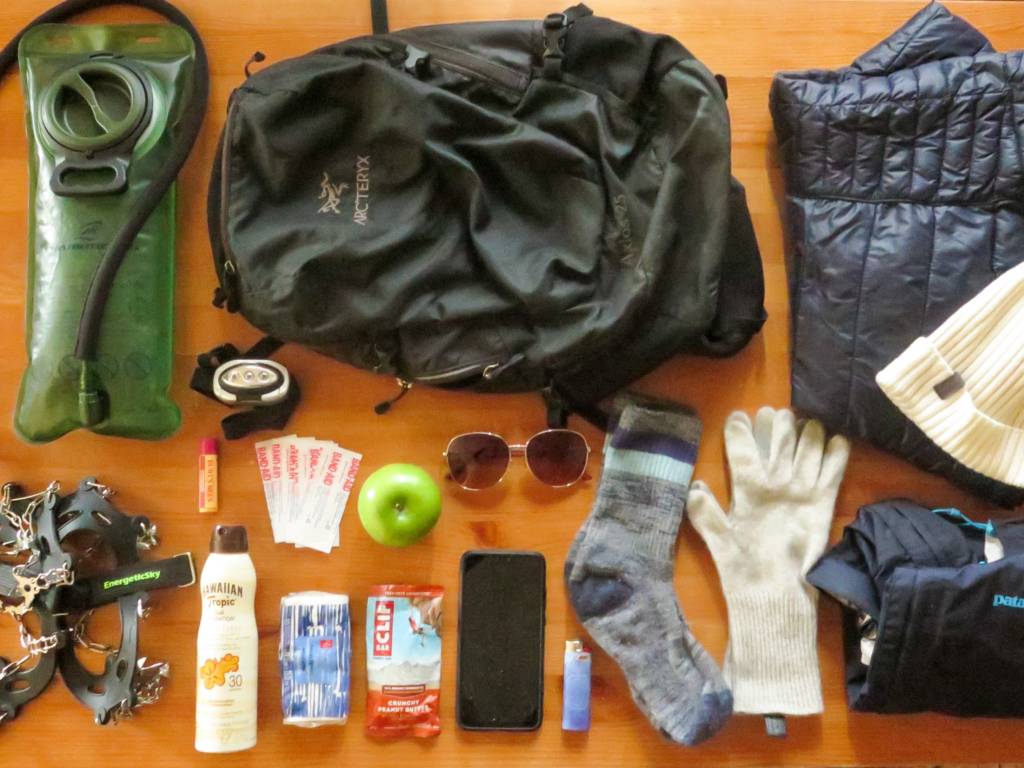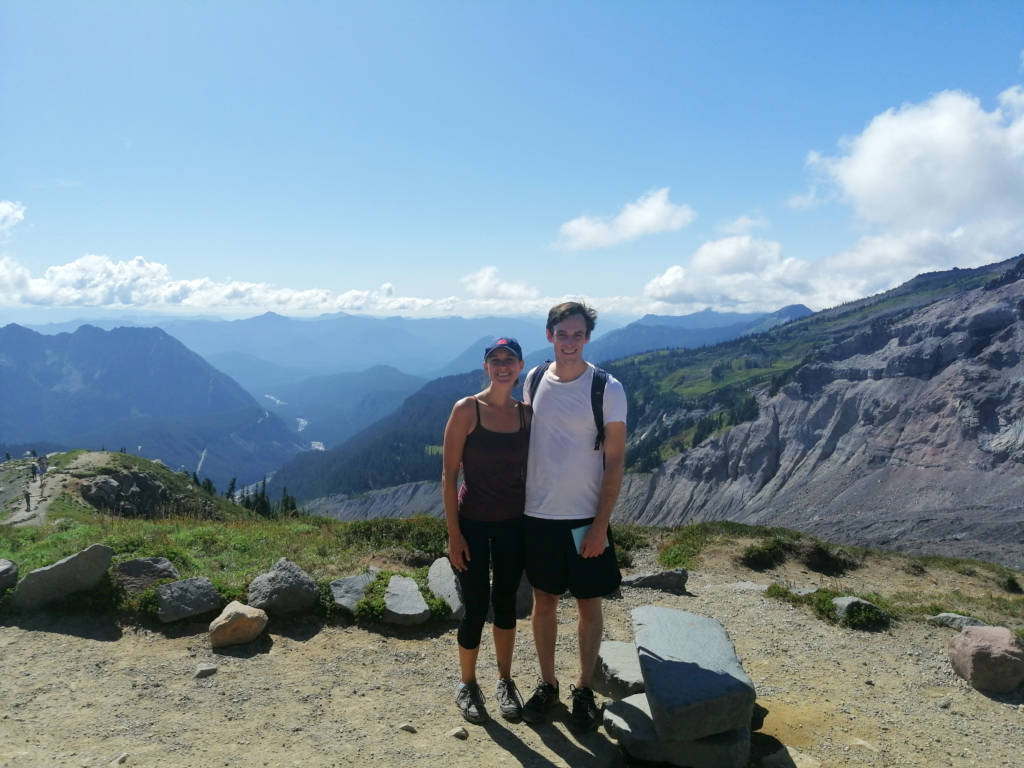I like to keep a little paper checklist of all of the things I like to have in my backpack on a simple summer day hike. Whenever I am getting ready to go I read this list and make sure I have everything checked off to ensure the most comfortable hike for myself.
These are things I bring for a summer hike in British Columbia, Canada. Of course, if you live somewhere where it’s warm year-round this might be a year-round guide for you. I have a separate list of things I always bring on a Canadian winter hike that you can read here.
These are my bare minimums for a hike that I know is marked, traveled, and safe. If I was going for a longer trip or into an unmarked area I would bring more gear and more safety devices. I always advise you to do your research before you go and assess what you will need to be as wilderness-conscious and safe as possible.
Always go prepared, its never cool to be that person who wanders into the woods with no water, no jacket, and no food and has to beg people around them for the bare necessities as they are stranded in the wilderness dehydrated, freezing, and starving. With that, let’s get on to the list!
What’s in My Pack

1. Water – Plenty of this basic life necessity. I always fill up my 2-liter water bladder (I only got one about 6 months ago and I can never go back). I also always bring another spare bottle of water to keep in my pack because sometimes it’s hard to tell if you are about to run out of water in the bladder and it’s nice to have some for backup if necessary. Make sure you stay hydrated on the trail, always bring more water than you think you will need. If you prefer it, or if you will be trekking for a long time, bringing a water filter might be right for you.
2. Hat and/or Sunglasses– I always bring a ball cap with me, it keeps the sun, sweat, and hair off of my face, and doesn’t keep slipping down the bridge of my nose like my sunglasses always do. I usually bring both anyway. The trail will be much more enjoyable if you don’t have to squint all the time.
3. Layers – even if it’s hot out you should always be prepared for any weather, getting dark before you expected, a cold summit, or even the chance of getting lost and stranded. I always carry at least a rain jacket (being from the Pacific Northwest I never leave my rain jacket at home) and a second layer like a hoodie or puffer jacket. I will also frequently bring fresh socks to replace wet or sweaty ones (this can help with blisters too!)
4. Sunscreen – forgetting this one can be quite painful, especially if you are on an exposed hike. If I know I will be mostly in the woods and only out for a few hours, I will put it on right before I head out and leave the rest in the car, but I almost always carry it with me.
5. Band-Aids and/or Blister Pads – I have had blisters show up completely randomly after months of breaking in a pair of hiking shoes so I always have some sort of band-aids or moleskin to fix my feet whenever a problem pops up. Sometimes I will even put band-aids on before the hike in places I know tend to rub. It’s also good to have some band-aids as part of the most minimal first-aid kit. If you are going with other people, it’s a well-traveled trail, and its only a day trip, usually band-aids will be all you need, just stay smart out there.
6. Food – even if I am just going on a short hike I will always at least bring a granola bar. If something happens or the trail ends up being longer than expected it’s good to have some sustenance. Being calorie deficient in the middle of the wilderness when you know you only have your own legs to take you home is miserable. You can find my favorite day hiking meals here.
7. Headlamp or Flashlight – someone always laughs at me for bringing a headlamp on a day hike in the middle of the summer when the sun doesn’t set until 10 pm, but this is a must-have safety item for me. If you get lost or the trail ends up being much longer than expected, you don’t want to be trying to find your way in the dark. Usually they take up minimal space and are very light, so why take the risk of not having one.
8. Chapstick – A luxury item. I’m one of those people that has to have chapstick with them wherever they go, it can be super refreshing on a mountain. The air gets thinner, colder, and dryer, as you climb and it’s much easier for your lips to get dried out and chapped, especially if you are also dehydrated. Just bring it along, one of these days you will thank me.
9. Bear Spray – this is location dependant, but here in Canada, you shouldn’t go anywhere in the wilderness without bear spray. Make sure it is easily accessible too. The best bear deterrent is simply being loud. Make plenty of noise on the trail whether that’s talking to friends, whistling (a favorite of mine), or wearing a bear bell. Letting the bear know where you are and not surprising it is the best bear repellant. Hopefully, you will never have to use the bear spray. Bear spray is one of those things that for me is so important about being an aware, independent hiker with good nature etiquette.
10. Cellphone – listen, folks, I know this sounds dumb, people bring their phones everywhere with them, so why would I even list it. I know there are a few people out there who think it might be nice to leave their phone in the car and just connect with nature. However, we are blessed with this lifesaving technology that we carry in our pocket.
A cellphone can act as a compass, a map, a flashlight, and of course, if you get lost or injured you can use it to call for help. The other important thing to note about cellphones is that as long as they are on, they can be tracked, even if its on airplane mode. So if you are lost in the wilderness, keep your phone on, and search and rescue should be able to track you.
11. A Map – I don’t necessarily mean go to your local outdoors store and pick up a large paper map and a compass (though if you are going on a longer, less traveled hike, this is a good idea). Usually, on a day hike, you just need a downloaded map off of an app to look at on your phone, or even a screenshot could do. Unless it is a trail that has been significantly altered by humans and has zero intersecting trails, there is always a chance of getting off course, and being able to peek at a map every once in a while is reassuring.
12. Tissues – does anyone else’s nose start running as soon as you start exercising and the air is a little cooler than you expected? Wiping your nose on your sleeve is gross, bring some tissue (they are also good for if you need a bathroom break in the forest – remember to pack it out).
13. Bug Repellant – depending where you are you might not need bug repellant at all, but it’s great to get some relief from those mosquitos when they are around. I would recommend doing a bit of research before you buy bug repellant and look for one that is mosquito AND fly repellant. The biting, swarming horseflies can make you lose your mind halfway up a mountain.
14. A Lighter, Matches, or Flint – again, a no-brainer when it comes to potential survival if you get lost or stuck somewhere when it gets cold. It weighs almost nothing, just toss it in your pack.
15. A Friend or Family Member Who Knows Where You Are – this is another tried and true safety trick. If you are missing and no one knows where you are, your phone is dead, you don’t have service, you have wandered off the trail and haven’t seen anyone in ages, this is where that friend or family member is so important. The wilderness is massive and one person knowing the trail you were on can help search and rescue massively and potentially save your life.
This is another thing that weighs nothing (since I guess technically it isn’t “in your pack”). It takes one minute to just text someone “hey, I am going out hiking today on such and such trail on such and such mountain and I will text you again when I get home before dark”. And voila, there’s the best safety net you could have.
Some other options are posting on an online hiking group, or at the bare minimum leaving a note on the dash of your car, reporting your route, time of departure, and the estimated time of return. It is hard to say when someone might notice this note though so I wouldn’t use this as a primary source of protection.
Optional Bonus: A permit – there’s a very strong chance you will not need a permit or liability waiver, but always double-check before you make the long drive to a trailhead, or you could be sorely disappointed.
What’s in My Car

I always keep a little basket of comfort items in the car for when I return from a hike. They may not be life or death necessities but it’s nice to have them after returning tired, muddy, and cold/sweaty from a hike.
Never leave valuables in your car. It’s tragic, but thieves do target cars in hiking parking lots because they know the owner will likely not return for several hours and there aren’t usually security cameras. Deter them by not leaving valuables in your car so that they can’t steal anything and they will *hopefully* not return in the future if they leave empty handed the first time.
1. A Spare Pair of Socks/Shoes or Sandals – Even if I only have a 30-minute drive home, by the time I reach the bottom of the hike, my feet are begging to be released from my muddy, sweaty hiking boots, and I appease them. In the summer I always bring by comfiest sandals in the car, as soon as I take off my hiking boots my feet do not want to be put back into another shoe. If I have blisters, putting on shoes is extra painful, and sandals let your feet breathe. The drive home is 1000% better.
2. A Full Water Bottle and/or Electrolyte Drink – if you drank all of your water on the trail, you are going to want to hydrate immediately. Sometimes these trailheads are out on a long backroad where you won’t have access to a store or a tap for a long time so it’s important to keep some reserve water for the end of your hike’ especially if you have consumed everything you took with you, which is common in the summertime.
3. Deodorant and a Spare Shirt – I don’t like to stink, okay!? Especially if we are popping into a brewery after the hike for a reward beer, I don’t want to ruin everyone else’s experience with my sweat. This item has a double use because I usually use the old stinky shirt I just took off to wipe the mud off my legs… you could also bring a towel for this.
4. A Snack – Same deal as the water, if you ate all of your food on the trail, you might be starving and don’t want to wait to eat something if you have a long drive back to civilization. Something small usually works for me like a granola bar, apple, or some trail mix.
5. A Car Phone Charger – So you used your excellent multi-tool of a cellphone for GPS to find the trailhead, to stay on the trail, then take a ton of photos, and your battery didn’t quite make it, but you aren’t 100% sure which winding backroad will take you back to the highway? Good thing you remembered your car charger! I have forgotten this one a fair few times and always regretted it- we just keep one in the car at all times now.
6. A Blanket – this is not necessarily a hiking must-have but a life must-have. I have always been told to keep a blanket or two in the car at all times just in case you get stranded for whatever reason. Plus they can be cozy after a long, cold hike.
Bonus: A Permit (again!) The likelihood of needing a pass or permit for parking is higher than needing one for the trail itself. Make sure you do your research before you go.
I am sure a lot of you are thinking ‘oh I don’t need any of this safety gear, nothing will happen to me, it’s a well-trekked trail, well guess what, people who think like that, are the ones that have something bad happen to them on the trail. Always be prepared. This is the most basic list, and many other hikers would tell you it isn’t enough, and in some cases, it isn’t. If it is a trail that isn’t well known or you aren’t sure of the distance or there has been bad weather, it is wise to think about further gear like maps, compasses, more layers, a water filtration device, and a better first aid kit. This is my bare minimum list, the things I bring on every trip, but always do your trail research beforehand and prep accordingly.
If you are new to hiking you might also benefit from my how to start hiking for cheap guide which you can find here.
Get out there and enjoy! Hiking is even more enjoyable when you know you are prepared!

Welcome to Alpine Feeling! My name is Talon, and I am a Vancouver local who loves hiking and all things outdoors. I am here to do my best to provide you with outdoor guides to the Vancouver area and beyond.


